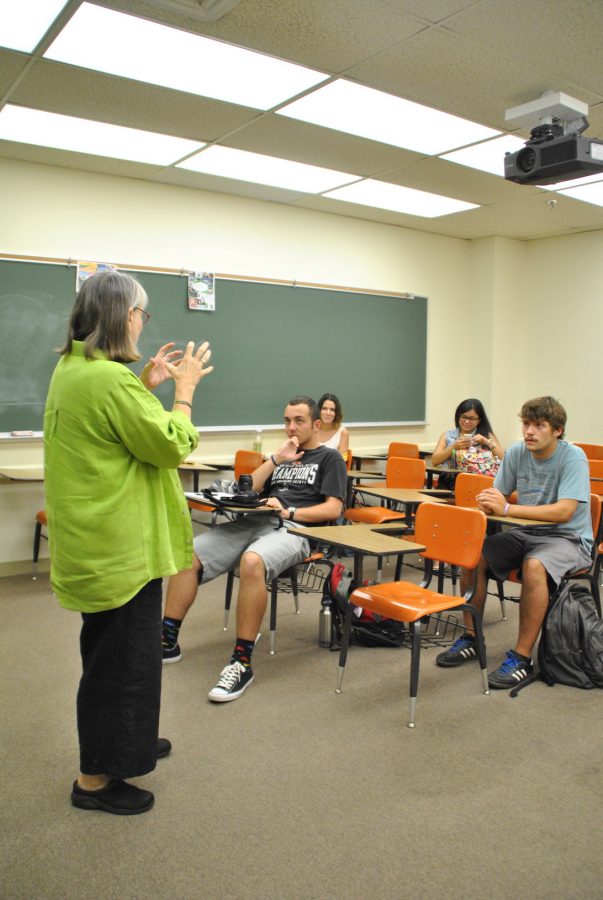Loyola restructures its colleges for the fall
Leslie Parr, A. Louis Read Distinguished Professor Of Communication, lectures a class in the School of Mass Communication. The School of Mass Communication was once part of the College of Social Sciences, but starting in the fall of 2016, it will be part of the new College of Arts and Sciences, along with other social science programs.
May 5, 2016
Loyola will be eliminating the College of Social Sciences as part of its college restructuring plan taking effect in fall 2016.
The College of Social Sciences currently contains majors such as mass communication, political science and criminal justice, among others.
Students in these programs will move to the new College of Arts and Sciences, which will be a merging of undergraduate programs in the College of Social Sciences with the existing College of Humanities and Natural Sciences. Graduate programs in the College of Social Sciences, such as nursing and counseling, will form a new college, the College of Graduate and Professional Studies.
The dean of the College of Arts and Sciences will be Maria Calzada, who currently serves as dean of the College of Humanities and Natural Sciences.
Calzada said the decision to reorganize was based around Loyola’s strategic “Transforming Loyola 2020” plan, which seeks to fulfill Loyola’s mission of delivering “high quality, experiential and values-based education.”
Calzada said that there were several options for changing the college structure, but she feels strongly that the one chosen was the best.
“I am very supportive of the proposed changes. I very much look forward to the new College of Arts and Sciences, with all its possibilities for collaboration and creativity,” Calzada said. “We considered many options, including keeping our current structure. In the end it was the view of the provost and the president that the new structure would serve our students best.”
With the creation of the new College of Graduate and Professional Studies, most of Loyola’s graduate programs will be held in a college separate of undergraduate programs.
Roger White, current dean of the College of Social Sciences, said this is a deliberate move to keep undergraduate studies at Loyola affordable.
“We do very well with our School of Nursing. It’s all about the mission, it’s all about community, but it’s also very profitable,” White said. “The idea here, which I’m very much involved with, is we want to try to keep the cost of undergraduate education from getting any greater than it needs to be. So by using these professional programs, which can be very profitable, we can offset the cost of education for the undergraduates.”
The move to change the college structure began with the starting of the “Transforming Loyola 2020” plan in the summer of 2014. It was during this same time that the faculty Senate formed an Ad Hoc Committee on Academic Structures that worked to produce recommendations for restructuring.
In the fall of 2014, the committee’s report became a starting point for the Provost’s Advisory Committee for University Restructuring. This committee then sent a report to the president and the provost, who made their final determination on restructuring in the spring of 2015.
Calzada said despite the massive changes to Loyola’s academic structure, students should not notice any interruption in services from the Dean’s office.
“Even though the new College of Arts and Sciences becomes official in the fall of 2016 we have been working to ensure a smooth transition,” Calzada said. “I think the new college structure in Arts and Sciences will provide our students with exciting opportunities for interdisciplinary, collaborative scholarship and will result in innovative programs. I am really looking forward to the fall and the new College of Arts and Sciences.”
Drew Brekus, economics sophomore whose major will be moving from the College of Social Sciences to the College of Arts and Sciences, does not believe that he will feel much of an effect from the changes.
“I know that my DPCL is going to be the same, so I don’t really mind that it’s been moved to the College of Arts and Sciences,” Brekus said. “Loyola obviously wants to have less faculty, so they’re going to have one department head for the school. Maybe it’ll be less bureaucracy on their part.”
The creation of the College of Arts and Sciences will also be a revival of sorts. White said the university previously had a college of that name.
“After Katrina, there was a reorganization and the old College of Arts and Sciences was reorganized,” White said. “Parts of it went to form the College of Music and Fine Arts, and most of the social sciences got together with some of the more professional, graduate programs and became the College of Social Sciences.”
Seniors graduating in the spring of 2016 will be the last to graduate from the College of Social Sciences before it moves into the College of Arts and Sciences. With the merging of the College of Social Sciences with the College of Humanities and Natural Sciences, the new College of Arts and Sciences will be the largest of the colleges at Loyola, with nearly 2,000 students expected in fall of 2016. Loyola’s other existing colleges: the College of Business, the College of Law and the College of Music and Fine Arts face no structural changes.








